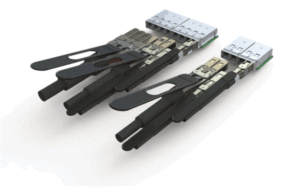RCx MSA Offers New Alternative for Data Centers to Connect Servers
The cabling system promises to streamline rack interconnect systems.
Companies that design components for Ethernet systems will want to take a look at the RCx Multi-Source Agreement (MSA), a new intra-rack connection technology aimed at Ethernet applications. RCx MSA, an industry working group with members from Amphenol, Broadcom, Dell, Hewlett Packard Enterprise, and JAE Electronics, Inc., set out to define new specifications for a simple, low-cost, low-power option for 25–100Gb/s connectivity. The resulting RCx is a passive, modular, and high-density copper cabling scheme for server adapters and network switches. RCx stands for Rack Connect x(lane) There are three RCx configurations: RCx1 (25 Gb/s), RCx2 (50 Gb/s), and RCx4 (100 Gb/s). The final specification was released in August of 2017, and multiple connector suppliers are now developing working prototypes for variations of the cable and connector.

Amphenol ICC’s RCx passive connector and cable system
Amphenol will be the first supplier to release an RCx interconnect, the RCx-1 for 25GbE transmission to the market. Currently, only prototypes are available. Other companies, are expected to follow in the near future. JAE now has working prototypes of RCx MSA cable assemblies and connectors. While it is not technically a standard, the RCx will be a powerful influence on future designs for Ethernet applications.
Kenta Minejima, industry marketing manager for JAE, says that the RCx will spur development of accompanying components. “For connector suppliers, we will need to develop new tooling to support RCx, since there are no connector components that can be reused from existing connector types, such as SFP or QSFP,” he said. “Engineering resources are also required to ensure that both mechanical and electrical performance requirements are met, but the lack of active components in the cable assembly means less time and money is required for development. Similar to any new standard, it can seem risky to develop early on, but the early investment will pay off.”
Making the switch won’t make sense for everyone. Many designers will opt to stick with the existing SFP28 and QSFP28 standards that have been widely adopted for 25GbE, especially for longer length rack-to-rack or switch-to-switch connections. Since RCx was designed with only short-length copper applications in mind, there are no provisions for adding active components for longer-length cables. However, for targeted applications, RCx uses the lack of active components as an advantage to help streamline and reduce overall system size.
“The limited cable lengths allow a very small and simple the paddleboard to be used inside the plug, and therefore the entire connector design can be significantly smaller compared to SFP and QSFP,” said Minejima. And it’s not just a matter of saving space. “Removing all active components from the cable assembly also potentially reduces cost and power consumption.”
Additionally, RCx does not require an EEPROM to identify the cable, so that means it is much simpler, but this also means it could be considered less customizable. Other benefits include the fact that both the cable and connector have the potential to be much less expensive than SFP28 because they will be smaller and have no active components, says Minejima. However, the unit cost of RCx will depend on total units built, so the actual cost savings will ultimately depend on the popularity and rate of adoption of RCx.
The existing SFP28 and QSFP28 standards will continue to be in play for many data center designs. SFP28, which stands for Small Form-Factor Pluggable 28, is the third generation of the SFP interconnect systems designed for 25G performance per the IEEE 802.3by specification (25GBASE-CR). QSFP28 stands for Quad Small Form-Factor Pluggable 28. It is the third generation of the QSFP interconnect systems designed for 25-100G performance per the IEEE 802.3bj specification (100GBASE-CR4). These general-purpose, “point-to-point” connector and cables systems are widely used to connect network equipment like switch-to-switch or switch-to-server applications. They are commonly used in data centers for ToR (top of rack) or MoR (middle of rack) switch applications. Additional break-out cables are typically required to complete a connection.
Joe Dambach, new product development manager, Molex, says that the SFP28 and QSFP28 standards still offer many advantages, including media flexibility, support for fiber optic modules, AOC’s, and DAC. SFP28 and QSFP28 will continue to be part of the evolution of Ethernet.
“We are constantly working to improve SI across these product lines, in light of growing bandwidth needs in the data center and elsewhere,” said Dambach. “At 400Gb/s, many current technologies can still be leveraged, in fact, this was always the intention when encoding was implemented to increase overall data rate. To get to the next potential node (800Gb/s), is a major challenge, as the intrinsic bandwidth of the components must double.”
Molex and other companies that support the SFP28 and QSFP28 standards don’t see the RCx as the next step in managing increasing Ethernet speeds; instead, they see it as a parallel technology.
Lisa Huff, Bishop & Associates’ Telecom Director and expert on data center and telecommunications technologies, is reserving judgment on the RCx — for now. She says, “The SFP28 and QSFP28 are established products in the industry. While data centers are always looking to increase density, they also want flexible solutions and the SFP28 and QSFP28 provide that flexibility. They can be used for either copper or fiber.”
As the RCx comes into production and finds its place in upcoming designs, we’ll learn more about how this new option could influence the development of future data centers.
- Meet the Connector: DIN Standard Connectors - April 16, 2024
- Software-Driven Radio Reinvigorates Old Technology - April 9, 2024
- What is a Busbar? - April 2, 2024





